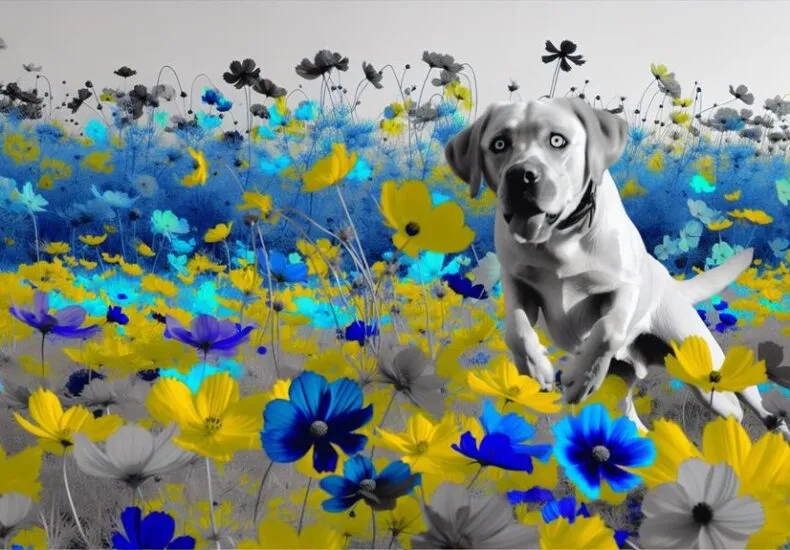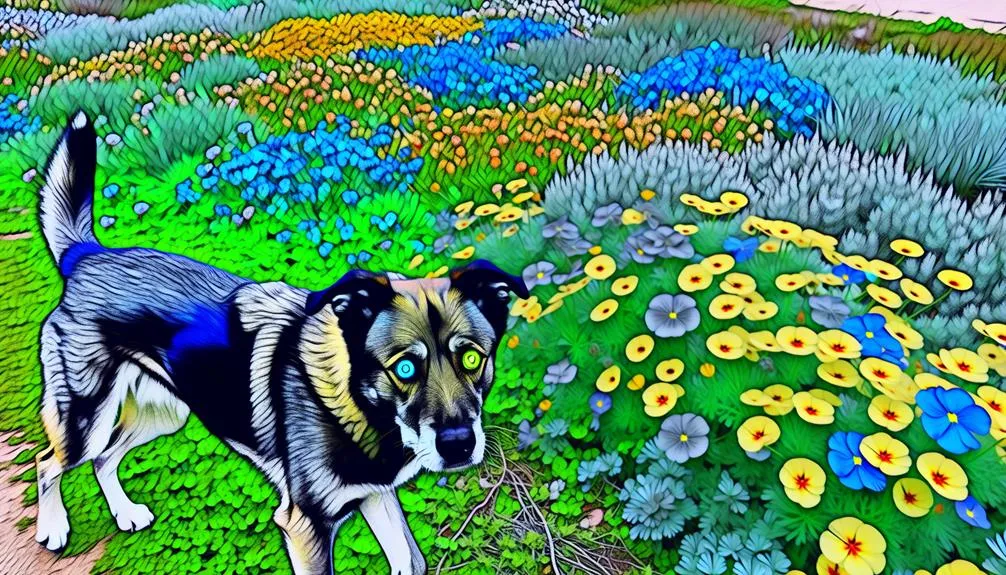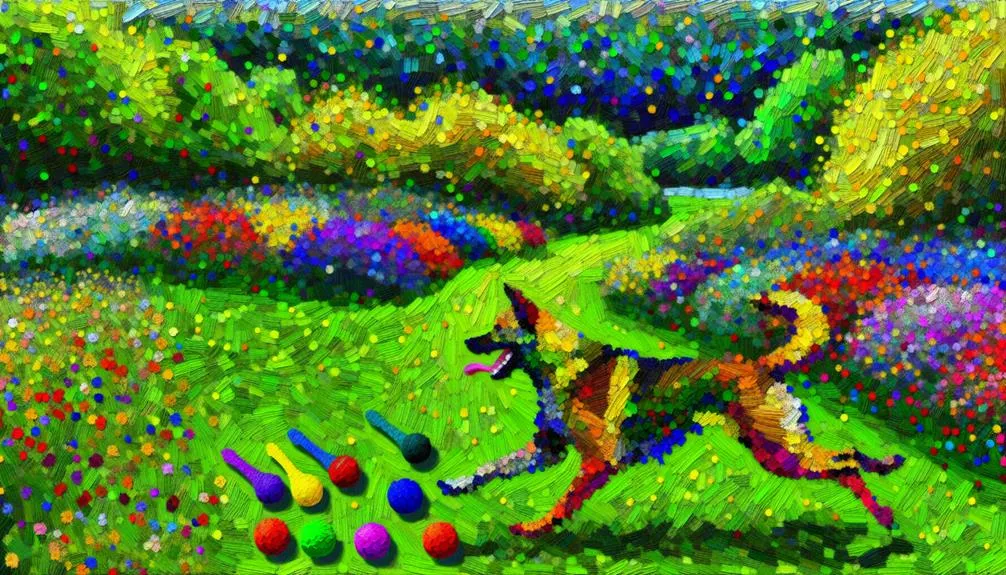
What Colors Can Dogs See
You might wonder if dogs really see the world in the same way we do, or if their color perception is fundamentally different. While it's often said that dogs are colorblind, the reality is more nuanced. They primarily see shades of blue and yellow, but struggle with reds and greens, which can lead to a misunderstanding of their environment. This unique vision affects not just their interactions with toys, but also their overall behavior. What implications does this have for how you engage with your dog?
Canine Vision Overview
When it comes to understanding how dogs perceive the world, their vision differs considerably from ours. Canine eyes are structured to adapt to various lighting conditions, giving them remarkable night vision. This ability stems from a higher number of rod cells in their retinas, which are sensitive to low light. As a result, dogs can see well in dim environments, making them exceptional companions for nighttime activities or tasks.
However, when it comes to visual acuity, dogs don't quite match human capabilities. While you may see clearly at a distance, dogs have a more limited range of sharp vision. Their visual acuity is estimated to be around 20/75, meaning they need to be much closer to an object to see it as clearly as you would from farther away. This limitation is partly due to the fewer cone cells in their retinas, which are responsible for detecting fine details and colors.
In addition to these differences, dogs also have a broader field of view, allowing them to detect movement more effectively. This is beneficial for hunting and tracking, where awareness of surroundings is key. Overall, while dogs excel in night vision, their visual acuity is less refined than yours. Understanding these differences can help you appreciate how your dog interacts with the world, from maneuvering through the dark to recognizing familiar faces at a distance.
Color Spectrum Differences
Dogs perceive colors differently than humans due to the composition of their retinas. While humans have three types of cone cells that allow for a broad range of color perception, dogs possess only two types. This difference considerably restricts their visual spectrum, specifically in their ability to distinguish between certain colors.
To understand this better, let's break down the differences in color perception between humans and dogs:
| Color Type | Human Perception | dog Perception |
|---|---|---|
| Blue | Seen vividly | Seen vividly |
| Green | Seen vividly | Limited perception |
| Red | Seen vividly | Poorly perceived |
| Yellow | Seen vividly | Limited perception |
In the table above, you can see how dogs' visual spectrum differs from yours. While you can easily identify a broad array of colors, dogs primarily see shades of blue and yellow. Their inability to perceive reds and greens leads to a world that's less vibrant for them. This restricted color perception is a result of the absence of certain wavelengths that human eyes can detect.
Understanding these differences helps explain why dogs may react differently to various colored objects. For instance, while a bright red ball may stand out to you, it might appear more like a dark gray or brown to your dog, affecting how they interact with their environment.
Colors Dogs Can Perceive

Approximately 20% of the color spectrum is visible to dogs, allowing them to perceive a limited range of hues. Unlike humans, who can see a wide array of colors thanks to three types of cone cells, dogs primarily have two types. This difference in color perception means that their world is less vibrant, mainly consisting of shades of blue and yellow.
Here are three key colors that dogs can perceive well:
- Blue: Dogs can see blue quite vividly, which makes it one of their favorite colors. Toys or objects in blue may be more engaging for them.
- Yellow: Similar to blue, yellow is also well within a dog's visual capabilities. This color can stand out in their environment, making it easier for them to spot.
- Gray: Dogs perceive various shades of gray effectively, which allows them to discern between different tones and contrasts, especially in lower light conditions.
While dogs may not see colors as we do, their visual acuity is adapted for motion detection and tracking. This ability is essential for their survival instincts and hunting behaviors. Understanding how dogs perceive color helps us appreciate their unique perspective of the world. By recognizing that their color perception is limited, you can tailor experiences and environments that resonate more with their vision, enhancing their quality of life.
Impacts on dog behavior
Since a dog's color perception is limited, it can greatly influence their behavior and interactions with their environment. Dogs primarily see shades of blue and yellow, while red and green appear more muted. This restricted color palette can affect their preferences for toys, training tools, and even their reactions to various stimuli. For example, if you use a blue ball during playtime, your dog may show a stronger preference for it compared to a red one, which they might perceive as grayish. Understanding these color preferences can enhance your training and bonding experiences.
Behavior modification can also be influenced by a dog's ability to perceive colors. When training your dog, using colors that appeal to them can help reinforce positive behaviors more effectively. If you notice your dog responds better to a yellow or blue training target, incorporating those colors into your sessions may lead to quicker learning and better engagement.
Moreover, knowing how your dog perceives colors can help you design an environment that encourages desired behaviors. For instance, using specific colored mats or markers can signal different areas for relaxation or play, aiding in behavior modification strategies.
Enhancing Your dog's Experience

To enhance your dog's experience, it is essential to reflect on their unique color perception and how it affects their interactions. Dogs primarily see shades of blue and yellow, while reds and greens appear more muted to them. This understanding can help you choose toys and activities that engage their senses more effectively.
Here are three ways to enhance your dog's experience:
- Choose Interactive Toys: Opt for toys that incorporate blue and yellow colors. Interactive toys that squeak or move will capture your dog's attention better, making playtime more enjoyable. Look for options that stimulate their problem-solving skills, as this can lead to increased satisfaction.
- Design Outdoor Environments: Create outdoor spaces that include various textures and colors that are visually stimulating for your dog. Incorporating blue and yellow elements, like toys or even flowers, can enhance their ability to explore and enjoy their surroundings.
- Engage in Color-Specific Games: Use colored items in games like fetch or hide-and-seek. Toss blue or yellow balls and observe how your dog reacts. This can turn a simple game into a mentally stimulating activity that strengthens your bond.
Frequently Asked Questions
Can Dogs See in Complete Darkness?
Dogs can't see in complete darkness, but they have superior night vision due to increased light sensitivity. Their eyes contain more rod cells, allowing them to detect lower light levels better than humans.
Do dog Breeds Perceive Colors Differently?
You might think dog breeds perceive colors wildly differently, but it's not that dramatic. While color perception varies slightly, most breeds see a limited spectrum similar to humans with red-green color blindness. Differences aren't pronounced.
How Does Aging Affect a dog's Vision?
As dogs age, their vision changes markedly. Aging effects can lead to visual impairments, impacting eye health. Conditions like cataracts or retinal degeneration are common, affecting a dog's ability to see clearly and perceive their environment.
Can Dogs Recognize Their Owners by Sight?
Studies show dogs can recognize their owners' faces with over 80% accuracy. They rely on visual cues and facial recognition, allowing them to distinguish familiar people, which enhances their bond and understanding of you.
Are There Specific Toys That Are Better for Dogs' Vision?
When choosing toys, consider colorful toys that contrast well against their environment. Toy materials like rubber or fabric may enhance visibility, helping your dog engage more effectively. Bright colors and textures can stimulate their interest and playfulness.
Conclusion
Understanding your dog's color vision can help you tailor their environment and interactions for better engagement. By focusing on shades of blue and yellow, you can pick toys and accessories that stand out to them. It's a whole new ballgame when you consider how they perceive their world. So, by embracing their unique view, you're not just throwing them a bone—you're enhancing their experience and strengthening your bond.
You may also like
Archives
Calendar
| M | T | W | T | F | S | S |
|---|---|---|---|---|---|---|
| 1 | 2 | 3 | 4 | 5 | 6 | |
| 7 | 8 | 9 | 10 | 11 | 12 | 13 |
| 14 | 15 | 16 | 17 | 18 | 19 | 20 |
| 21 | 22 | 23 | 24 | 25 | 26 | 27 |
| 28 | 29 | 30 | ||||
Leave a Reply